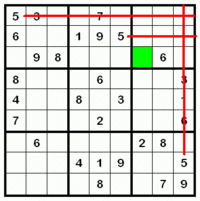SuDoku
How Many Different Styles Of Sudoku Exist
I would love to know how many variations of the game sudoku are out there? Does anyone have a clue? I love the game and would like to try as many different styles to test my skills. What’s the best site play a variety of styles on?
Congrats Thomas Snyder, U.S. Sudoku Champ!
Way to go, Thomas! If you ever get bored with Sudoku, try Alpha Sleuth sometime. :-)
Yehey
Sudoku is the reason I joined this website
I can use this web to answer sudoku puzzles
That's why I LOVE THIS WEBSITE?
yahoo! hey it googles...
- JJAR's blog
- Login to post comments
Legit scores called out as cheat scores
Jun 1st 2006, 10:22 PM
CHEATER! 00:07:41 144.60
Jun 1st 2006, 10:30 PM
CHEATER! 00:06:20 177.16
Jun 1st 2006, 10:37 PM
CHEATER! 00:06:56 267.40
I got these scores on my own, on smartprize.co.uk, but it said i cheated. what is up with the system?
Puzzles
Hi,
i wants to increase my creativity and inovation power.I think that this is one of the best way to make your mind upto date, through puzzels.
generators, solvers, problems
Is it validly SuDoku if more than one solution?
This online-playable SuDoKu was recently generated/offered at www.puzzle.ro/en/sudoku but has 3 solutions as shown:
____83__1 426783951 247683951 247683951
95_2_1__4 957261384 956271384 958271364 <(6/8)
3___457_2 381945762 318945762 316945782 <(8/6)
__5___2__ 845319276 485319276 485319276
16__57__9 162857439 162857439 162857439
_9_4__815 793426815 793426815 793426815
_7_______ 574632198 674532198 674532198
______643 219578643 521798643 521798643
___1_4_2_ 638194527 839164527 839164527
According to Wikopedia regarding SuDoku:
Sudoku Variants
Variants
Although the 9x9 grid with 3x3 regions is by far the most common, numerous variations abound: sample puzzles can be 4x4 grids with 2x2 regions; 5x5 grids with pentomino regions have been published under the name Logi-5; the World Puzzle Championship has previously featured a 6x6 grid with 2x3 regions and a 7x7 grid with six heptomino regions and a disjoint region. Even the 9x9 grid is not always standard, with Ebb regularly publishing some of those with nonomino regions. Larger grids are also possible, with Dell regularly publishing 16x16-grid Number Place Challenger puzzles and Nikoli proffering 25x25 Sudoku the Giant behemoths. Another common variant is for the numbers in the main diagonals of the grid to also be required to be unique; all Dell Number Place Challenger puzzles are of this variant.
Sudoku Solver
The goal of a Su Doku problem is to complete the published grid so that no number appears more than once in any row, column or 3x3 subgrid. To set up the solver, simply type the numbers printed into the corresponding squares in the grid below.
(The Tab and Shift-Tab keys allow the grid to be navigated without use of the mouse).
Sudoku Puzzles - Solution methods
Solution methods
|
The 3x3 region in the top-right corner must contain a 5. By hatching across and up from 5s located elsewhere in the grid, the solver can eliminate all of the empty cells in the top-left corner which cannot contain a 5. This leaves only one possible cell (highlighted in green). |
The strategy for solving a puzzle may be regarded as comprising a combination of three processes: scanning, marking up, and analysing.
Scanning
Scanning is performed at the outset and periodically throughout the solution. Scans may have to be performed several times in between analysis periods. Scanning comprises two basic techniques, cross-hatching and counting, which may be used alternately:
- Cross-hatching: the scanning of rows (or columns) to identify which line in a particular region may contain a certain number by a process of elimination. This process is then repeated with the columns (or rows). For fastest results, the numbers are scanned in order of their frequency. It is important to perform this process systematically, checking all of the digits 1-9.
- Counting 1-9 in regions, rows, and columns to identify missing numbers. Counting based upon the last number discovered may speed up the search. It also can be the case (typically in tougher puzzles) that the value of an individual cell can be determined by counting in reverse - that is, scanning its region, row, and column for values it cannot be to see which is left.
Sudoku Rules and Terminology
Rules and terminology
The puzzle is most frequently a 9x9 grid made up of 3x3 subgrids (called "regions"). Some cells already contain numbers, known as "givens". The goal is to fill in the empty cells, one number in each, so that each column, row, and region contains the numbers 1 through 9 exactly once. Each number in the solution therefore occurs only once in each of three "directions", hence the "single numbers" implied by the puzzle's name.
The attraction of the puzzle is that the completion rules are simple, yet the line of reasoning required to reach the completion may be difficult. Published puzzles often are ranked in terms of difficulty. This also may be expressed by giving an estimated solution time. While, generally speaking, the greater the number of givens, the easier the solution, the opposite is not necessarily true. The true difficulty of the puzzle depends upon how easy it is to logically determine subsequent numbers.






